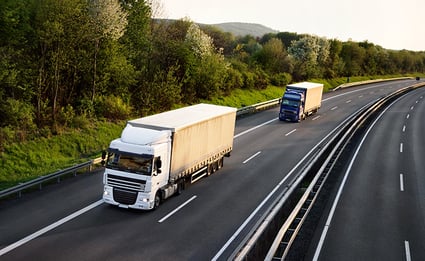This Solution Solves the Top Transportation Challenges
Keith LaBotz - September 22, 2022

One solution solves many of the top transportation challenges for supply chains, but it only works for companies that understand the last meter of last-mile logistics. Before we look at the last meter and its solution, check out a new survey from Inbound Logistics, 2022 Trucking Perspectives, which reports the most pressing priorities for trucking companies.
Source: Inbound Logistics, 2022 Trucking Perspectives
The remedy for most of these concerns lies in improving last-mile logistics, and it requires a critical piece missing from most last-mile solutions: the last meter.
This article explains the last meter and how Vehicle Routing and Scheduling (VRS) with load optimization can use it to resolve top transportation challenges.
Supply Chains Must Focus On The Last Meter
You’re probably familiar with the “last mile” of a supply chain, the final stretch where an order ships to the customer. The journey ends with the customer taking possession of the goods ordered. This final step is the last meter, where freight travels from a delivery vehicle to the customer.
Completing the last meter is the goal of last-mile logistics solutions and supply chains, making it a mission-critical process. However, most last-mile solutions only focus on transportation to ensure delivery vehicles arrive on time. They stop managing the process at the most critical point, the last meter.
Solutions Most Focus on the Last Meter
While on-time arrival is essential for successful delivery, this diligence must continue into the final meter to prevent any possibility of failure. Even if 100% of all delivery vehicles arrive on schedule, a failure can still occur, as the following example illustrates.
Consider an automotive supplier optimizing its corporate delivery fleet with transportation planning and vehicle routing and scheduling (VRS) solutions. One of their trucks arrives on time at the customer’s site, only to discover the delivery sitting in the nose of the trailer behind ten other shipments.
Does the driver abort this delivery to save the remaining ten deliveries or unload the truck at the expense of the other ten?
The Answer is VRS with Load Optimization
The answer is a VRS solution with load optimization capabilities. It takes delivery optimization to the next level to keep shipments moving without disruption through the last meter of the supply chain.
What Is Load Optimization?
Load optimization minimizes delivery costs and risks by fully utilizing cargo capacity. An effective load optimization solution directs the loading of freight into vehicles. Combining routing and load optimization in a VRS solution provides the highest degree of optimization, minimizing the number of vehicles and drivers in a delivery fleet.
A VRS solution with load optimization evaluates a mind-numbing array of constraints and scenarios. Shipping containers, trailers, and delivery vehicles are optimally loaded with freight to enable the most efficient transportation possible.
Product and packaging characteristics introduce inventory detail which impacts material handling decisions, like unloading and transferring goods in the last meter.
Load Optimization Mobilizes the Warehouse
Load optimization brings inventory details into the transportation picture, allowing a last-mile solution to treat delivery vehicles more like mobile warehouses on wheels. Inventory is organized in a warehouse to enable efficient workflow, and the same applies to a delivery fleet.
Orders are loaded and unloaded more rapidly, increasing productivity. More information improves decision-making, enabling a last-mile solution to manage the delivery process with greater agility, right up to the last meter.
Some of the parameters used when optimizing and organizing each delivery vehicle include:
- Driver: maximum driving hours, familiarity with vehicle and routes.
- Vehicle: cargo hold volume, maximum loaded weight, liftgate, and door configuration, speed permitted on roads, the center of gravity, fuel range, speed
- Freight: weight, packaging, size, pieces, stackable, special handling, fragility, security risk, environmental requirements, transportation regulations, material handling equipment needs.
- Customer: delivery window, loading dock constraints, yard wait times.
- Routes: driving speed, weight and street width limits, traffic patterns.
- Orders: delivery commitments, customer requirements specific to the order.
Optimized Loads Reduce Errors
VRS solutions that include load optimization produce more effective and reliable delivery plans. When load optimization is not part of the routing process, product constraints can be missed, resulting in a risky or invalid delivery plan.
A VRS with load optimization ensures reliable delivery plans and prevents errors like these from occurring:
- products that cannot be stacked loaded into a trailer where they cannot fit without stacking;
- fragile items requiring air-ride suspension loaded into a trailer routed along a bumpy highway;
- hazardous freight transported in a vehicle packed with products prohibited from traveling with it.
Optimized Loads Reduce Miles Driven
A VRS solution with load optimization reduces miles driven to their absolute minimum. The impact is shorter driving hours, higher productivity per mile, lower fuel bills and emissions, fewer vehicle inspections, and less wear and tear on vehicles.
Optimized Loads Reduce Returns
Vehicle and road restrictions factored into load optimization decrease the risk of damaged freight, reducing returns. More deliveries complete the last meter without incident, eliminating the expense of transporting and processing returns.
Optimized Loads Reduce Costs
Fewer routes, fewer miles, fewer returns, fewer vehicles, fewer drivers, fewer gallons of fuel, fewer emissions, and shorter driver hours? The benefits from these reductions go beyond lowering operating costs:
- Driver retention improves with a more efficient, trouble-free delivery process.
- Customer satisfaction improves with lower-cost, reliable delivery.
Conclusion
VRS with load optimization enables higher levels of transportation optimization, minimizing costs and improving delivery performance. By extending a last-mile logistics solution into the last meter, the resulting benefits resolve most of the top concerns of transportation companies.
flexis AG provides a VRS solution with load optimization that can provide your company with the capabilities discussed in this article.
INTERESTED IN MORE INFORMATION?
LATEST POSTS
- Understand Circular Economy in The Manufacturing Industry
- How Can Industry 4.0 IT Integration Be Achieved Smoothly?
- The Significance of Order Sequencing in Discrete Manufacturing
- How to improve your Supply Chain Management: The Power of Control Towers
- Optimizing Human Resource Scheduling in Manufacturing: A Technological Approach


